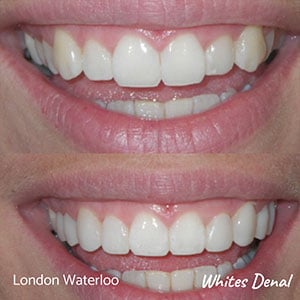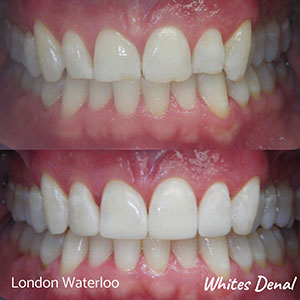Can You Chew Gum With Veneers?
Call us on 0208 616 0590 or email us at [email protected] to book an appointment.


Veneers in London Waterloo
More and more people in London are taking up cosmetic dentistry procedures such as veneers (porcelain and composite veneers) to improve the appearance of their teeth and smile. At Whites Dental, our cosmetic dentists are here to help create a beautiful new smile for you. We provide a wide range of cosmetic procedures in London Waterloo, including porcelain and composite veneers, bonding and smile alignment.
What is a veneer?
Dental veneer is a thin layer of porcelain made to fit over the front surface of a tooth, like a false fingernail fits over a nail to re-create the natural look of teeth, while also providing strength and resilience comparable to enamel. Occasionally a natural-colour ‘composite’ material is used instead of porcelain. They can be used to repair chipped, stained, misaligned, worn down, uneven or abnormally spaced teeth. Porcelain veneers are long-lasting dental restorations designed to withstand normal biting and chewing. If you have veneers, you should be able to chew gum without a problem. Chewing gum isn’t sticky enough to harm the integrity of your veneers. Add to this the fact that most people chew gum with their molars, away from their restorations, and there isn’t much cause for concern. Because of the strong chewing forces that are generated in the back of the mouth, veneers are rarely placed on molar teeth However, keep in mind that traditional gum is made with sugar, which can lead to cavities. Cavities are problematic because veneers are only as strong as the teeth to which they are bonded. Choose a sugarless gum to protect your natural teeth and ensure the long-term success of your veneers. Chewing sugarless gum for 20 minutes after you eat can even help prevent tooth decay by increasing saliva production.
Foods to Avoid After Getting Veneers
While veneers are durable, it’s possible to damage them if you aren’t careful. The same things that can harm your natural teeth can also harm your cosmetic restorations. Avoid biting hard foods or objects, chewing on ice, and using your teeth as a tool. These actions can chip a veneer or cause it to come loose. Once you get your permanent veneers in place, there are far fewer restrictions on what you can eat. Caring for them, though important, is also a bit easier than caring for temporaries. The best thing about permanent porcelain veneers is the fact that they are less susceptible to stains and can be easily polished. So, even if you get some stains on your teeth, your dentist will be able to remove them in a few minutes. However, you need to remember than even though porcelain veneers are strong, in order to protect them and reduce the need of professional cleanings, it is advisable to avoid some types of food in your diet.
During the first few days, it is essential to be careful with them. Try eat softer foods until you get used to your new veneers. You should also avoid hard foods such as ice, rock candy, and nuts. Some individuals may need to continue special care for a bit longer. Your dentist will offer more information on this if it applies to you. After this time, apply the same rules as you would to normal teeth in terms of how to care for them and protect them. However, you will need to be a bit more cautious and more aware of what you are eating, how you are biting, and how you are cleaning them.
Some foods should be avoided with porcelain veneers, though the list is fewer, it is still important to avoid these foods to help protect your veneers for a longer period of time. Avoid:

- Consuming alcoholic beverages often as alcohol softens the surface of the bonding material.
- Taking stain-causing drinks often like tea, coffee and red wine. Porcelain veneers are highly stain-resistant while the bonding material and teeth beneath them are not at all.
- Biting on hard food (nuts, ice, rock candy, etc)
- Tobacco chewing or smoking
- Although veneers are extremely durable, they aren’t quite as strong as natural teeth. For this reason, we do not recommend that you chew on very hard objects, such as pens, ice, nails, bones, etc. Although it is unlikely, your veneers may chip if you chew on these or other hard objects.
Of course, these are only recommendations. If you cannot give up eating specific food or drinking tea, you should try rinse your teeth with water after each meal and maintain a good oral hygiene. And as for drinking tea or coffee, try drinking with a straw to minimise the contact of the liquid with your new veneers. An ideal variant is to brush your teeth after colouring food or beverages. The longer the food stays in contact with your teeth, the greater chances of getting stains you have. Avoid hot and cold food and drinks., if you experience increased teeth sensitivity after the procedure. It is also recommended to take small bites and cut the food into pieces. Avoid biting and chewing with excessive force. In situations where you have to eat hard food, we recommend you to chew with your back teeth. Porcelain veneers are not unbreakable and if not properly cared they can break and chip. Your porcelain veneers can last for many years if you look after them.

Are veneers permanent?
They’re permanent, but they’re not forever. Bonding cement is a substance that microscopically creates bridges from your real tooth to the porcelain so that it adheres to your tooth and becomes one, think of it as the glue for a press-on nail—only you can’t get this one off once it’s on. After the bonding cement is in place and the veneer is on your tooth, the bonding cement is cured with a UV light to secure everything in place. With that said, veneers could last for about 15 to 20 years, at which point they’ll need to be replaced. To replace veneers, you gently drill off the old veneer, and start the new process over. Don’t worry, more of your natural tooth does not get removed when they take the old ones off; dentists typically wear microscopic glasses to make sure they’re not drilling into the natural tooth.
It’s important to consider all of the options available to you. Your dentist will be able to explain the different processes and advise you about which treatment best suits your individual needs.
If you need more information regarding veneers, you can visit our cosmetic dentistry homepage– https://www.whitesdental.co.uk/cosmetic-dentistry/
At Whites Dental, some of the Central London’s leading cosmetic dentists work with us, providing patients cosmetic treatments such as bonding, porcelain veneers and composite veneers. We cover the following areas in London – London Waterloo, Southwark, Central London, Elephant and Castle and London Bridge. This page provides more details on whether you can chew gum with veneers. We are based in London Waterloo, next to Southwark Tube station and very close to London Waterloo rail station. We are also between 6 to 14 minutes’ walk from Elephant and Castle tube station, London Bridge, Borough Market, Blackfriars station and Southbank.

